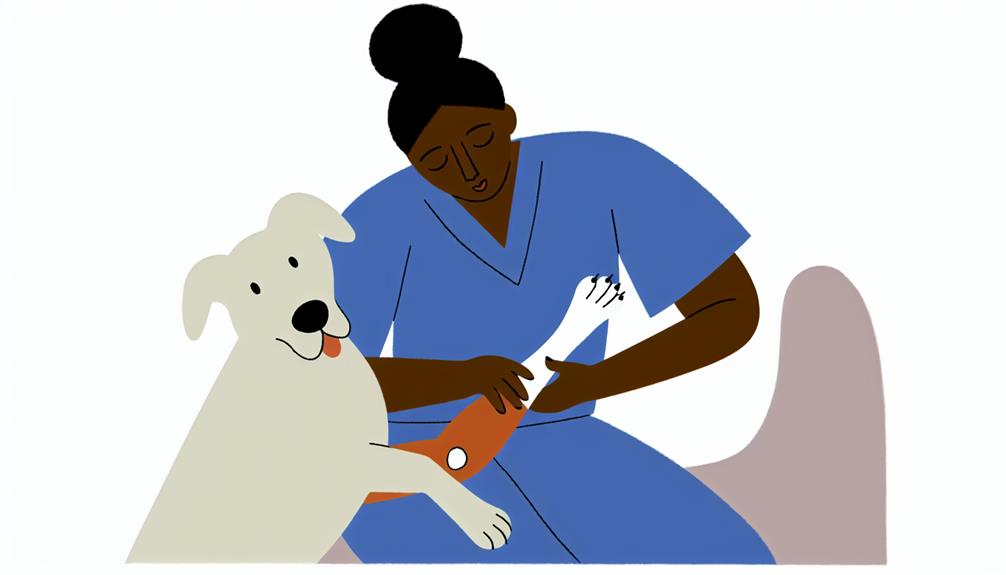
13 Feb Why Choose Canine Musculoskeletal Therapy for Your Dog?
Imagine your dog running freely through a meadow, their muscles strong and their movements graceful. Now, picture them struggling to walk, hindered by pain and discomfort. Canine musculoskeletal therapy offers a solution to help your furry friend regain their vitality and joy.
But why should you choose this therapy for your dog? Well, it goes beyond just relieving pain. Canine musculoskeletal therapy can improve your dog's overall well-being, prevent future health issues, and provide them with a happier, healthier life.
So, let's explore the many benefits and reasons why this therapy may be the best choice for your beloved canine companion.
Understanding Canine Musculoskeletal Therapy
To understand canine musculoskeletal therapy, it's important to recognize that it focuses on treating issues related to the bones, muscles, ligaments, and joints in dogs. This therapy takes a holistic approach, combining natural treatments such as massage therapy, acupuncture, chiropractic adjustments, and hydrotherapy. By addressing both the musculoskeletal and neurological aspects of a dog's health, this therapy aims to improve mobility and reduce pain.
Massage therapy plays a crucial role in canine musculoskeletal therapy. It involves the manipulation of soft tissues to relieve muscle tension, increase blood circulation, and promote healing. This hands-on approach not only provides physical benefits but also helps to establish a bond of trust and comfort between the therapist and the dog.
Acupuncture points are another essential aspect of this therapy. By stimulating specific points on the body, acupuncture can help alleviate pain, reduce inflammation, and restore balance to the body's energy flow. This ancient practice has been proven effective in treating various musculoskeletal conditions in dogs.
In addition to massage therapy and acupuncture, other treatments like chiropractic adjustments and hydrotherapy may be included in a holistic dog's care plan. Laser therapy, which uses focused light energy to promote healing and reduce pain, is also commonly used in canine musculoskeletal therapy.
Benefits of Canine Musculoskeletal Therapy
By undergoing canine musculoskeletal therapy, dogs can experience a range of benefits that improve their overall well-being and quality of life. This therapy utilizes techniques such as massage, laser therapy, and other modalities to address musculoskeletal issues in dogs. One of the key benefits of canine musculoskeletal therapy is its ability to enhance blood circulation. Improved circulation helps deliver oxygen and nutrients to the muscles and tissues, promoting faster healing and reducing inflammation. It also aids in the removal of metabolic waste products, supporting the overall health of the musculoskeletal system.
In addition, musculoskeletal therapy can reduce stress and anxiety in dogs. The gentle touch and comforting techniques used by a skilled massage therapist for dogs can help dogs relax and unwind. This can be especially beneficial for dogs who've gone through traumatic experiences or suffer from anxiety-related issues. Moreover, canine musculoskeletal therapy can also improve lymphatic flow, which plays a vital role in the immune system. By stimulating the lymphatic system, this therapy helps remove toxins and waste materials from the body, supporting the dog's overall health.
Furthermore, musculoskeletal therapy can be beneficial for dogs with various health issues. It can alleviate pain and discomfort associated with conditions such as arthritis, hip dysplasia, and muscle strains. It can also aid in the recovery process after surgery or injury, promoting faster healing and reducing the risk of complications. Regular sessions of musculoskeletal therapy can also strengthen muscles, tendons, ligaments, and joints, promoting better physical function and flexibility in dogs.
Conditions Treated by Canine Musculoskeletal Therapy
Canine musculoskeletal therapy is a highly effective treatment option for a wide range of conditions in dogs. It can be a great help for dogs suffering from arthritis, muscle strains, ligament injuries, and joint stiffness. By targeting these specific conditions, musculoskeletal therapy aims to alleviate pain, improve mobility, and enhance the overall quality of life for your furry friend.
In addition to these common conditions, musculoskeletal therapy is also beneficial for post-surgical rehabilitation. After undergoing surgery, dogs may experience limited range of motion and difficulty with movement. With targeted therapy, dogs can recover faster and regain their mobility more effectively.
Dogs with spinal issues, such as herniated discs, and gait abnormalities can also benefit from musculoskeletal therapy. The therapy sessions focus on improving the strength and flexibility of the muscles surrounding the affected areas, helping to alleviate pain and improve overall mobility.
Furthermore, musculoskeletal therapy is especially beneficial for dogs with hip dysplasia. This condition, which affects the hip joint, can cause pain and difficulty in movement. By targeting the affected area and working on muscle strength and joint stability, musculoskeletal therapy can provide relief and improve the dog's quality of life.
How Canine Musculoskeletal Therapy Works
If your dog is experiencing musculoskeletal issues, understanding how canine musculoskeletal therapy works can help you provide the necessary care and support for their bone, muscle, and joint health. Canine musculoskeletal therapy takes a holistic approach to improving your dog's musculoskeletal system. It involves various techniques such as chiropractic adjustments, therapeutic massage, acupressure, acupuncture, and hydrotherapy.
These therapies aim to reduce inflammation, improve mobility, and support the natural healing process in your dog's musculoskeletal system. Massage techniques used in therapy help to increase blood flow to the affected areas, promoting healing and reducing pain. Acupuncture and acupressure target specific points on your dog's body, stimulating the flow of energy and relieving tension.
Laser light therapy and physiotherapy are also utilized to target soft tissue, damaged tissue, and manage pain. Laser light therapy can improve blood flow, reduce inflammation, and promote tissue regeneration. Physiotherapy involves exercises and stretches tailored to your dog's specific needs, helping to improve strength, flexibility, and mobility.
By integrating these natural therapies with a holistic approach, canine musculoskeletal therapy not only addresses the immediate issues but also enhances your dog's overall well-being. It strengthens their immune system, prevents future injuries, and promotes long-term musculoskeletal health.
Understanding how canine musculoskeletal therapy works empowers you to provide the best care for your dog's bone, muscle, and joint health.
Choosing the Right Canine Musculoskeletal Therapist
When choosing the right canine musculoskeletal therapist for your dog, it's crucial to consider their certification, experience, and holistic approach to ensure tailored care for your furry friend's specific needs.
Here are some factors to consider when choosing a canine musculoskeletal therapist:
- Certification: Look for a certified canine musculoskeletal therapist who's undergone specialized training in treating dogs' musculoskeletal issues. This certification ensures that the therapist has the necessary knowledge and skills to provide effective treatment.
- Experience: Ensure that the therapist has experience working with dogs of various breeds, ages, and health conditions. This experience allows them to understand the unique needs of different dogs and provide individualized care.
- Holistic Approach: Verify that the therapist uses a holistic approach, considering your dog's overall well-being. A holistic therapist takes into account not only the physical aspects but also the emotional and mental well-being of your dog. They may also collaborate with veterinarians to ensure comprehensive care.
- Positive Reviews: Check for positive reviews and testimonials from other dog owners who've benefited from the therapist's services. This feedback can give you confidence in their abilities and the quality of care they provide.
Remember to also consider the therapist's availability for follow-up sessions and adjustments to the treatment plan as your dog's needs evolve. Choosing the right therapist will ensure that your dog receives the best possible care for their musculoskeletal issues.







No Comments